Bunnies And Burrows Part I
Bunnies And Burrows
Well, I did get a request for the Midnight At The Well Of Souls RPG, but after doing an exhaustive look at one sci-fi RPG, I wanted a bit of a change of pace, and B&B was in the same section of my library (The “really rare shit I’m really proud to own and will grab in a fire once I know the cats are safe” section). Bunnies & Burrows was the first game published by Fantasy Games Unlimited (FGU), also the makers of Space Opera.
This one doesn’t have stellazon space pirates, or sentient asparagus, but it does have bunnies. And burrows.
Click for more. With pictures of bunnies! (But no sexy space pirates.) (Well, there’s a rabbit space pirate…)
In Which We Randomly Digress To The Cambrian
One of the many patterns you see in the world, if you see the world in patterns, is that of invention/rapid adaptive radiation/collapse&consolidation/progression. You see this in the evolutionary history of life, you see this in the development of new product categories, and you see it very nicely in the history of gaming. Dungeons & Dragons appeared, and it triggered a massive explosion of ideas and concepts flying out in all direction. The vast majority of those early experiments died off quickly, and a small handful started to define new standards, and from those standards came a more orderly, slower, pace of progress.
Science geeks may recognize the term “Burgess Shale“. This is a famous bit of paleontological lore, a section of rock laid down in the Middle Cambrian, after this whole “multicellular life” thing had taken off but no one was quite sure what to do with it yet. It contains a number of entities that represent large branches of the Tree Of Life that basically fell off early on, creatures only barely connectible to modern life. During the first few years after Gygax said, “Hey, let’s see what would happen if we had dragons attack Saxons”, a whole lot of things appeared, some slavish copies of D&D, some realizing there were rich treasures of imagination to be mined in genres such as science fiction and superheroes, and one that decided that what gamers really wanted was a chance to play rabbits.
Not mutant rabbits that turned things to rubber and wielded assault rifles, mind you.
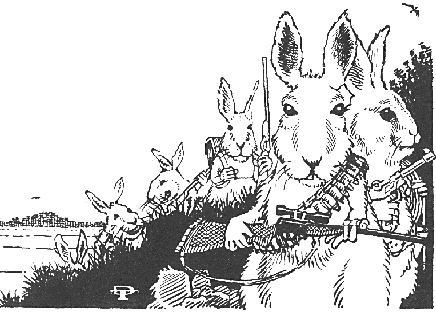 |
| You Don’t Get To Play These Bunnies |
You played perfectly normal, average, bunnies. And by “perfectly normal and average”, I mean, “they rode other rabbits like mounted knights and apparently built war towers in the fields”, which might tip off Farmer MacGregor that something odd was happening down by the old Atom Mill.
Yes, The Flag Has A Carrot On It
The rulebook is 74 pages, center bound (there’s probably some official publishing term for it, but I mean “Stapled Through The Middle”), with a fair number of small sketches bunnies drawn by “this guy I know, he draws and we can pay him with pizza”, the source for much game art of this era. It is set in a fixed-width typewriter font, with formatting limited to ALL CAPS and underline, which pretty much implies it was laid out on a typewriter and then the art was pasted in as needed. Again, this is not atypical of the era.The book also includes a piece of yellow cardstock which has a whole bunch of charts, also laid out on typewriter, that appears to contain the most important tables and rules. To judge from this, the game uses the “lettuce leaf standard” for currency, with the current exchange rate being 10 lettuce leaves for one apple. I wonder what that is with inflation? Do modern-era bunnies say to their kin, “I can’t believe I paid 200 lettuce leaves for this apple! When I was your age, it was only 190 lettuce leaves!” (Bunnies don’t live long, so, y’see, it’s not all that different and I’m just going to let this joke crawl off into the corner and sob itself to death.)
So how does it work? How do you make a bunny? (Well, first, a mama bunny and a daddy bunny love each other very… oh, wait, we’re talking bunnies, here. A mama bunny and a daddy bunny meet at a seedy biker bar and pretty soon there’s a massive gangbang going on and then there’s about 20 baby bunnies.)
But if you want to know about character creation, read on!
In Which Bunnies Are Produced
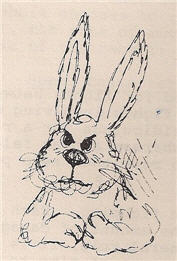 |
|
| Classic Art By “This Guy I Know” | |
We start with what is now the boilerplate “What the frack kind of game is this? Where’s the board? How do you win?” essay. It has the curious circumlocutions of the era, possibly spurred by TSR being forced to change “hobbit” and “balrog” in D&D to “halfling” and “balor”. While many modern games feel little fear about citing inspirations, Bunnies & Burrows refers only to “a currently popular novel” (hint: Rhymes with ‘Slaughtership Clown’), and mentions no other games by name, merely speaks of games “dominated by Sword & Sorcery orientations”. It is also worth noting that the game’s genre is referred to as “multi-player fantasy games”. The term “role playing game” was still evolving, and if the game was published in 1976, it is quite possible that term for this new class of games simply wasn’t yet in common use. (The term does not, for example, appear in the original D&D booklets.)
Anyway, just in case you were wondering if the only thing you could do as a rabbit was eat, sleep, groom, breed, or get eaten, it assures us that you’ll be playing a rabbit which can carry things looped around its neck, count to 4, tell stories, and use healing herbs and psychic powers.
Our Characteristics Go To Eight!
Bunnies & Burrows starts with all six of the D&D characteristics, and then add Speed and Smell, all rolled on 3d6. Smell is, of course, how well you can smell things, not how much in need of a bath you are. (The exact opposite of the classic game “Ogres & Oubliettes”). Well, it looks like it’s rolling time on the ol’ rabbit farm!
Strength: 14
Speed: 7
Smell: 12
Intelligence: 12
Wisdom: 9
Dexterity: 9
Constitution: 7
Charisma: 7
This, folks, is why I like point-buy systems. The dice hate me. Ah well, gotta play ’em as you roll ’em when you’re kickin’ it old school! (Because nothing says “Gangsta” like playing a rabbit.)
Apparently, you have a level in each characteristic, which is certainly an innovation for the era, with your characteristics themselves rising independently. You start, of course, at Level 0 in each. This is nice; raising rolled attributes was generally difficult or impossible in most games of this time. You had skills or class levels but barring magic or the like, what you rolled at the start was what you died with. Often within one fight.
There’s eight professions, one associated with each characteristic. You can pick a profession you’ll suck at, but it’s recommended you pick the one which matches your highest characteristic. For me, that’s Fighter, which is Strength based, and has the associated skills of Fighting and Jumping. The other options, for the record, are:
Speed: Runner
Smell: Herbalist
Intelligence: Scout
Wisdom: Seer
Dexterity: Maverick
Constitution: Empath
Charisma: Seer
Huh. D20 Modern’s “Strong Hero, Smart Hero, etc”, 20-odd years ahead of schedule.
The next section is titled “Strength Rules”. Yeah, you better believe it does, baby! Whoooo!
No, wait, this is rules regarding Strength. My bad.
Hit points equal 4+your strength level (0)+your Constitution level (0), or… let’s see…. 10 percent of nothin’… divided by nothin’… carry the nothin’… 4. Because I’m a fighter, though, I get to add 1 hit point for every five levels of Strength, so I get +1 hit points, or… 5.
Of course, this wouldn’t be a 1970s game without multiple resolution systems. My jumping ability is equal to my strength score in feet, and does not increase with my strength LEVEL, so I can jump… 14 feet? That’s… pretty darn impressive. (For you Europeans reading this, in metric, 14 feet is… uh… 5.7 cantons, or 12.1 hectagongs.)
By “declaring as a fighter”, in addition to my +1 hit point, I do +1 damage with each hit, and my Strength of 14 means I get +5% in clawing. (If it was 15, I’d get 5% in clawing and biting.)
Speeding Along
The next section is the Speed Rules. My Defense Class is equal to my Speed/2, rounded down, or 3, but I get a +1 for being a fighter, so, 4.
So, here we are, barely 5 pages into the game, and we’ve seen the following mechanics:
a)Add attribute levels, ignoring attribute value.
b)Use attribute value as written.
c)Gain a percentage bonus based on where in a range of number an attribute falls.
d)Divide attribute value.
My “running speed”, the distance I can run in a minute, is determined by my Speed, too, which means “Look at a chart which has yet another breakdown of ranges and take a fixed number”. In this case, my Speed of 7 means I can run 20 yards in one minute. (All rabbits hop at a fixed rate of 10 yards/minute. ) Running requires more “energy”, which has not yet been explained, but it might make sense to hold off explaining a mechanic in detail when the reader doesn’t yet know what it’s for. (I mentioned this inevitable Catch-22 of complex systems in the Star Rovers article; it’s not an easily solved problem.)
Having done 2 of 8 attributes, we now get… combat rules. Well, maybe Strength and Speed are the only attributes that matter for combat?
Rabbit Fire Action! (Like “rapid fire”, only, it’s “rabbit”, ’cause it’s a pun and… oh, forget it.)
Anyway, I’m not going to go into great detail on the combat rules, except to note that the first paragraph informs you the rules assume a fight between two rabbits (including what they call “cardboard’ rabbits and what everyone else will eventually called “NPCs”), and that you should make modifications if the fight involves other animals. I am not sure, having not peeked ahead, but I’ve got a sneaking suspicion these “modifications” will not be explitly defined, or even illustrated with examples. Just a hunch. It does note that a rabbit can’t pin a bear, and a bear falling on a rabbit might actually do some damage to it. The basic “to hit” rule is to get one percentage value by cross-indexing the Strength level and the Defense Class, then a second percentage value by cross-indexing the attackers and defenders fighting styles, you add them, and roll less than that to hit, then you look at a chart to see how much damage you did based on the attack type, then you roll 1d10 and if it’s a 0, you scored a critical hit, effect of which is determined based on the hit location. (Sorry, forgot the hit location roll.)
This “cross index attack mode and defense mode” mechanic was very popular in Ye Olden Dayse, because it reeked of “realism”, and offered a seemingly deep tactical experience with choices, as compared to the current D&D model of “Roll to hit, roll for damage”. You get the “I can use Attack X, which does a lot of damage, but if he’s using Attack Y, I will…” The problems with this model were:
a)God help you if you wanted to expand the game. The idea of “game expansions” was pretty new, so a lot of systems weren’t built with supplements in mind, then they realized supplements was the business model gamers wanted and expected. You either expanded the chart until it grew to poster size, or you used something like “Spinning Flying Back-kick uses the to-hit matrix for Reverse Uppercut, but with +5% against Leaping Dragon and -15% against Hopping Toad”. Both options sucked, and this design pattern rapidly fell into disfavor.
b)A combination of analysis paralysis and DM “cheating”. Does the DM pick a defense mode before the player announces his? How do you know he’s being honest? Do you make him write it down? For each combatant?
But back to bunnies.
Following combat, we’re back to Attribute rules, this time, Smell. There’s a lot of rules here, including yet another mechanic — if your Smell is 9 or greater, you have a 2-in-6 chance of determining if an unknown food is fit to eat. There’s also a bunch of stuff on Smell Clarity and Smell Type and various herb preparations and the level of your Smell attribute you need to do them. A non-herbalist has to have 13th level Smell to Pick Off Bugs; an Herbalist, only 5. I felt you should know that.
Oh, there’s a full page table of herbs, what they do, how to prepare them, and so on, which the GM is encouraged to rip up and throw away(metaphorically) prior to play(!), in order to screw over players who’ve read the rules and already know what to do with the herbs! “Don’t let the players act on knowledge their characters don’t have” was not a big aspect of play back then, it seems. Possibly because RPGs were still evolving out of wargames, the concept of a semi-adverserial relationship between players and GMs, with players looking for every possible edge and GMs looking to smack them down, was fairly strongly assumed. The “implied social contract” of the game table was still in a very early draft.
(The smell rules are 10 pages long; the entire combat section, 6.)
Intelligence is next, beginning with a discussion of traps. Rather amusingly, even though “man smell” is the key to a trap being a trap, you use intelligence — not smell — to figure this out, with yet another “Range of attribute/fixed percentage chance” chart.
We also have languages… a lot of them, divided into “Ordinal” (such as “Common Carnivore”) and “Familial” (Canine, Feline, Ursine…). You gain one additional language per Intelligence level, limited by Intelligence score, so my bunny, who is named… uh… Hickory, I guess… can learn up to 12 languages. The rules bow humbly and please to beg honorable forgiveness for “simplifying” the relationships of animal species in terms of linguistics, and recommend that the GM add more languages to draw more distinctions between species. Let’s compare this to D&D 4e, where there are ten languages in the entire universe. Also, the time it takes to learn a language is based on how smart the teacher is, not how smart you are, so with a good teacher, you can learn a language in as little as 10 minutes! Bite me, Rosetta Stone software!
(Scouts learn two languages per level and can learn up to twice their intelligence in languages.)
Wisdom Of The Ages
I just want to say, as an aside (Gasp! An aside, digression, note, comment, or addendum? In this blog?), that the “Group rules by attribute” system is a pretty nifty mechanism for organizing a gamebook. It wasn’t widely adapted, though, probably because many game systems quickly came to rely on multiple attributes.
Wisdom is the attribute for Seers, and it covers all sorts of psychic things. Normally, to do anything cool with Wisdom, you need Trance Points, which are equal to your Wisdom Level (x2 for Seers), but you start with a Wisdom level of 0, but you need to do Wisdom things to gain a Wisdom level, so there’s a loophole — if you have a Wisdom level of 0, you can try to view the future, instill fear, or feign death, without spending Trance Points, but you have a crappy chance of doing so, based on a chart. The “Level 0” rule basically creates a separate chart and mechanic for these abilities, that is tossed away once you’re past level 0. Welcome to the 1970’s, folks. We programmed in Applesoft BASIC with horrible spaghetti code, and we made sure our roleplaying games used “cross index attack and defense and roll a D20” if you fought with a dagger and “roll under your skill on percentile dice” if you fought with a sword. If you fought with a dagger in one hand and a sword in the other, well, it involved a pile of D4s and an angry vole.
Oh, just because we can, there’s another mechanic here, namely, abilities keyed to attribute level — a Seer with 10 Wisdom levels can instill Shock in animals other than rabbits, and if his Wisdom level is 20, he might even be able to mind control other animals! (The GM is left to determine if this is possible.) There’s also the ability to communicate telepathically with other rabbits, and possibly non-rabbits, with the length of the communication “being roughly dependent on the range between the two rabbits”, and if you think this means there’ll be a chart, table, or other guide to even give you a starting point as to whether this is a minute or an hour or a word or if the distance is feet or miles or light years, then, you don’t know the 1970s.
We move on to Dexterity, and Lizard reveals a pernicious lie at the heart of the rabbit warren.
Dexterity And Deception
Dexterity governs what you can carry. I do see the logic here, as rabbits aren’t built for carrying things, so agility is clearly vital. Wait, you’re wondering about those rabbits on the cover, with the guard towers and the spears and the shields?
Yeah.
About that.
Y’see, it’s like this. Those rabbits… the ones with the weapons… and the ones illustrated by This Guy I Know, thoughout the book, the ones wearing helmets or pulling cannons(!) or riding on larger rabbits… those rabbits… uhm…
They’re not in here.
You’re playing a quadruped with no opposable thumbs. You may be of human intelligence and capable of seeing the future, but, dude, you’re a bunny. Not a rabbitoid. You can do what one might relatively sanely expect a sapient being with no thumbs could do, which is “not damn much”. Sure, working together, you can accomplish things a non-sapient rabbit never could, but you’re not going to be making shields, holding a spear, or building a freaking’ watchtower! Put as simply as possible, the cover, and much of the interior art, is one big, fat, lie. It illustrates a game other than the one you’re actually playing, and there’s nothing in the text of the game to indicate it was ever considered that you’d be playing a humanoid, thumbed, armed and armored rabbit.
You Don’t Get To Do This.
To put it another way:
 |
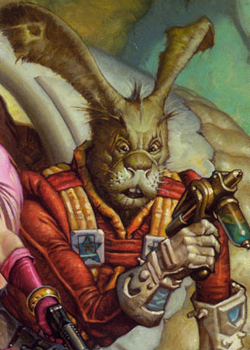 |
| YOUR PC |
NOT YOUR PC |
Glad we’ve got that straightened out.
And, you know what? This looks like a good time to break and save the rest for Part II.

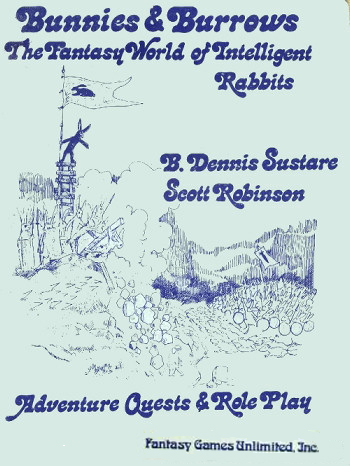
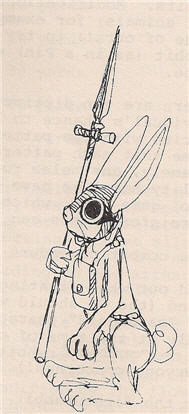
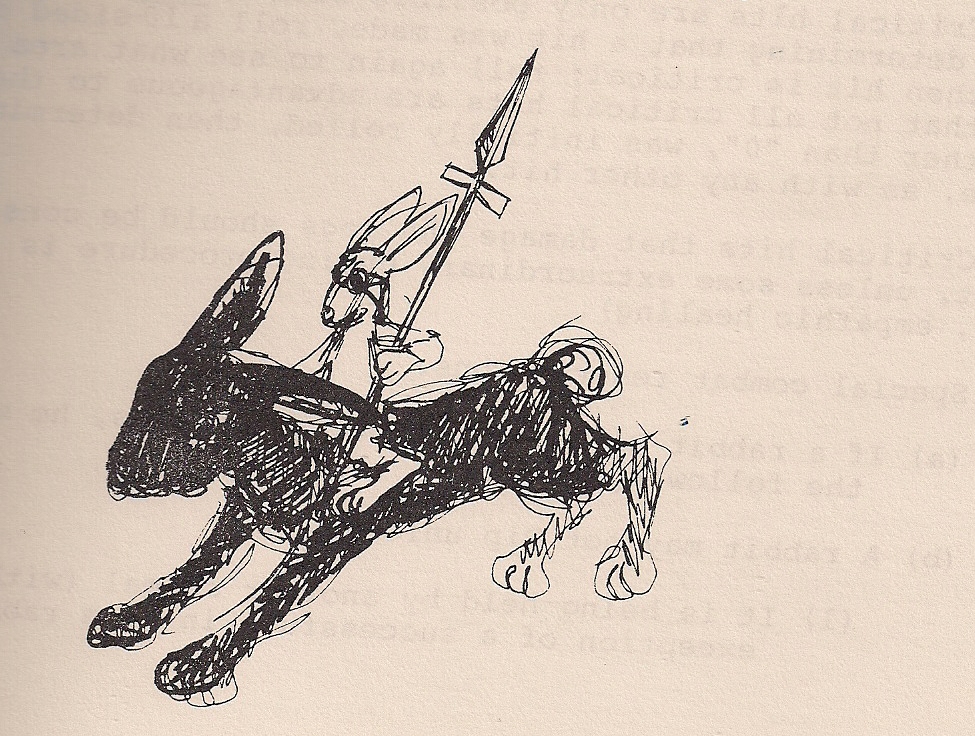
Pingback:Gangster – Lizard's Gaming and Geekery Site